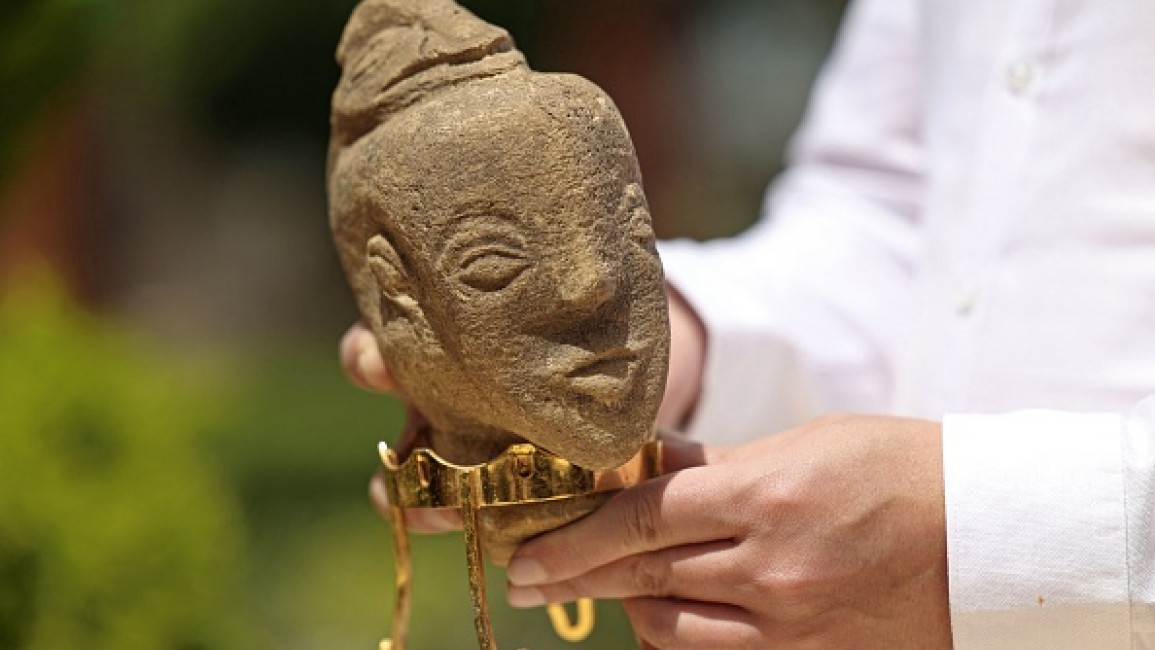4,500-year-old rare Canaanite goddess statue of 'Anat' unearthed in Gaza
The Hamas-run Ministry of Tourism and Antiquities in Gaza on Tuesday announced the discovery of a 4,500-year-old statue of the goddess "Anat" from the Canaanite era.
In a press conference held in Gaza, Jamal Abu Rida, Director-General of Antiquities and Cultural Heritage at the ministry said that the 22-centimetre-tall statue is believed to represent the Canaanite goddess Anat and is estimated to be dated to around 2,500 B.C.
The sculpture is made of limestone and is just a head wearing a snake for a crown, worn by the gods as a symbol of strength and invincibility.
"Anat was the goodness of love, beauty, and war in the Canaanite mythology," Abu Rida said during the press conference.
"One of the indications of the presence of this statue is that the land of Palestine and the Gaza Strip, in particular, has passed through many human civilizations, whether they were Canaanite, Roman, Byzantine, Islamic and other human civilizations, which invalidate the Zionist claim that the land of Palestine is a land without a people for a people without a land," he added.
The sculpture was discovered on Monday by Nidal Abu Eid, a local farmer, while he was cultivating his land in al-Qarara town of Khan Younis, according to Abu Rida.
"I found it by chance when I was cultivating my land. It was muddy but when I washed it with water, I realized that it is a precious thing," Abu Eid said to The New Arab.
"At first, I hoped to sell it to someone to make some money, but an archaeologist told me that it was of great archaeological value," the farmer said to TNA.
"I am so proud that our land still has great archaeological values. It means that this land is ours and we have a civilization and history for thousands of years BC, since the Canaanite times," Abu Eid added.
Anat, Anath, or Anatha is a major northwest Semitic goddess. Syria, particularly Ugarit and Mount Lebanon. Canaanites, Amorites, Egyptians (Elephantine), Libyans, and Hebrews all worshipped the goddess at one point.
Her attributes vary widely among different cultures and over time, and even within particular myths. She likely heavily influenced the character of the Greek goddess Athena.
Gaza was considered a trade corridor between the countries and empires, and it is normal to uncover archaeological sites that belonged to various royal families of the past, according to Abu Rida.
In February, Gazan builders discovered a 2,000-year-old Roman Cemetery in Beit Lahia in the north of the coastal enclave while they were preparing the area to construct an Egyptian-funded city.
In January, the ministry opened a reconstructed old Byzantine church in Jabalia refugee camp in the north of the Gaza Strip, turning it into a public museum after four years of work.
According to historians, the Byzantine church was established in the Gaza Strip around 1,700 years ago, and it was the property of the royal family at that time.
"Such archaeological sites will revive domestic tourism in the Gaza Strip and introduce people to the history of their region and its historical and geographical importance," the official said.





